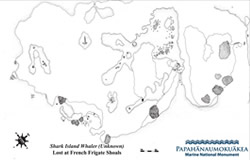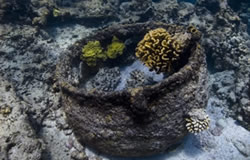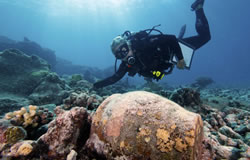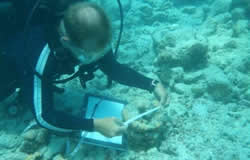Lightning Strikes Twice: The Real Life Sequel to Moby Dick
Lightning Strikes Twice: The Real Life Sequel to Moby Dick. This is the story of a whaleship lost on a remote reef, one very unlucky captain, and a team of archaeologists with the discovery of a lifetime.
In the middle of the night on February 11, 1823, the seafaring career of Captain George Pollard, Jr. came to a dramatic end in the remote Northwestern Hawaiian Islands. Having survived the tragic events of the Essex, one of the world's most infamous seafaring disasters, and the true life events that inspired Herman Melville's novel Moby Dick, Pollard optimistically set sail for the Pacific once again in the whaleship Two Brothers, believing with all his heart "that it was an old adage that the lightning never struck in the same place twice." In this case it did, and Pollard's promising career as a whaling captain came to a tragic end on an uncharted reef in the most remote archipelago on earth, and what is now Papahānaumokuākea Marine National Monument. In 2008, a team of NOAA maritime archaeologists discovered the first clues of the whaleship Two Brothers and began to unlock the mystery of the only Nantucket whaleship ever found on the seafloor.
Click here to watch the full film (You will be directed to a non NOAA server)
Lightning Strikes Twice: The Real Life Sequel to Moby Dick
Lightning Strikes Twice:
The Tragic Tale of the Nantucket Whaleship Two Brothers
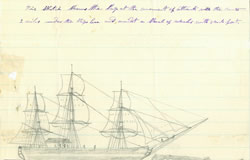
A sketch by Thomas Nickerson depicting the attack and sinking of the ship Essex. Credit: Nantucket Historical Association.
Many are familiar with the fate of the Nantucket whaleship Essex, stove by a whale in the Pacific Ocean and cited as the inspiration for Herman Melville's Moby Dick. After the tragedy of the Essex, Captain George Pollard and other survivors endured a 95-day journey in small boats that resulted in sickness, starvation, and, ultimately, cannibalism. However, this dramatic experience was not the final chapter in Pollard's career as a whaling captain.
After his return to Nantucket, he was given command of the whaleship Two Brothers, a vessel smaller than the Essex at 222 tons. The Two Brothers set sail for the Pacific, leaving Nantucket on November 26, 1821. She made her way around Cape Horn, up the west coast of South America, and headed towards newly discovered whaling grounds in the Pacific. Sailing in consort with the whaleship Martha, they encountered stormy weather in the vicinity of French Frigate Shoals in the Northwestern Hawaiian Islands. Not long after, the ship stuck the reef and found herself surrounded by breakers. Stunned by the disaster and by his horrible misfortune, Captain Pollard was reluctant to abandon the ship. The crew pleaded with their captain to get into the small boats, to which they clung for survival throughout the night. When they awoke, the crew found the Martha anchored in the lee of a fifty foot tall rock (now called La Perouse Pinnacle). The entire crew of Two Brothers was rescued and they headed back to Oahu.
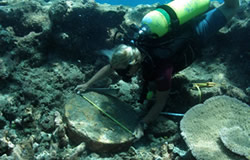
Dr. Kelly Gleason documents a grinding stone at the Two Brothers shipwreck site. Credit: NOAA/Smith.
Captain Pollard's career as a whaling captain was over, but the story of the Two Brothers still remains on the seafloor at French Frigate Shoals within Papahānaumokuākea Marine National Monument. The story of this shipwreck, and the mystery of her possible discovery, connects the small island of Nantucket with one of the largest marine protected areas in the world.
In 2008, a team of NOAA maritime archaeologists made an exciting discovery at French Frigate Shoals. Following over three weeks of successful survey in the Northwestern Hawaiian Islands, the team began to explore for new shipwreck sites at French Frigate Shoals using tow board surveys in an area near a historic anchorage. Within minutes of the first tow, the divers spotted a large anchor in approximately 15 feet of water. The age and size of this anchor gave the impression that it was not simply left as a mooring in an anchorage. After snorkeling around in the area, the team came across the first clue that this site was more than a lone anchor: a trypot set into a hole in the reef top. This discovery initiated a larger survey of the area, and soon two more trypots were discovered (for a total of three), another large anchor, and hundreds of bricks scattered in pockets of the reef. As the team explored further along the shallows, hawsepipes and the remains of standing rigging were discovered.
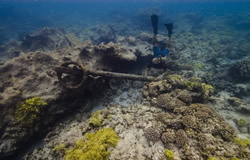
Dr. Kelly Gleason investigates an early 19th century anchor in the reef at the Two Brothers shipwreck site. Credit: NOAA/Casserley.
The discovery at French Frigate Shoals was certainly exciting. However, the identity of this unexpected find was a mystery. What ship could this be trapped on the sea floor beneath the waves at French Frigate Shoals for so long? The trypots and bricks clearly indicated a whaler, and features of both anchors point toward an early 19th century date. Only three whaling ships, all American vessels, have been reported lost at French Frigate Shoals: the South Seaman, wrecked in 1859; the Daniel Wood, wrecked in 1867; and the Two Brothers, the Nantucket whaler wrecked in 1823 and described earlier through her connection to the ill-fated career of Captain George Pollard.
In the summer of 2008, the NOAA maritime archaeology team collected a considerable amount of information at the mystery whaling shipwreck site including measurements, feature distribution, and the location of artifacts - all clues that will help the team determine the identity of this ship and how it came to its end. In 2009, the maritime heritage team returned to the unidentified whaling shipwreck site at French Frigate Shoals (referred to by the team as the "Shark Island Whaler" for the sandy island nearby) in order to conduct an ecological survey at the site. At this time, the team came across an exciting new portion of the wrecksite. In addition to the discovery of a fourth trypot, three blubber hooks, a grinding wheel, and a kedge anchor, the team found four small cast iron pots that resemble small trypots. There are records describing the sale of these type of cast iron pots in Nantucket for use on ships. The team also came across what appears to be the tip of a whaling harpoon, another exciting discovery with the potential to yield information about the identity of this site.

Photographic portrait of Thomas Nickerson who sailed with Captain Pollard on both the Essex and Two Brothers disasters. Credit: Nantucket Historical Association.
It wasn't until May of 2010 when a small team was able to return to the site that maritime archaeologists began to believe they were indeed looking at the scattered remains of the Nantucket whaleship Two Brothers. At this time, the team uncovered an incredible collection of whalecraft (the tools of whaling) on the seafloor. Four more whaling harpoon tips (for a total of five), four whaling lances, ceramics, glass, and a sounding lead (among dozens of other artifacts) all date to an 1820s time period with an American provenence. The preponderance of evidence suggested to the team that they were looking at the Two Brothers, the only American whaler lost at French Frigate Shoals in the 1820s. Both the South Seaman and the Daniel Wood were lost much later than the Two Brothers, and reports of their losses place them far away from the location of the Two Brothers shipwreck site. The team completed a second site plan carefully documenting the location of these artifacts south of the initial site discovery area from 2008. These site plans help maritime archaeologists better understand the process of wrecking, and compare it to the accounts of the survivors of the Two Brothers tragedy. Survivors describe a wrecking event so violent and confusing the sailors barely had the time to launch small boats and paddle away before the vessel became a complete loss on the reef.
In August of 2010, maritime archaeologists on the second expedition to the Northwestern Hawaiian Islands of the season acquired the permits to recover two more whaling harpoon tips, along with two whaling lances, ceramics, glass, and one of the cooking pots. These artifacts were thoroughly documented and will undergo conservation at the Heritage Resources Conservation Laboratory at the California State University at Chico under the direction of Dr. Georgia Fox. Once conserved and treated, the artifacts will be analyzed and returned to Hilo, Hawaiʻi to become part of the Monument's maritime heritage exhibit at the Mokupāpapa Discovery Center in Hilo.
It was an interest in learning more about the Nantucket whaling ship Two Brothers and her fateful voyage that ended in disaster at French Frigate Shoals in 1822 that inspired research at the Nantucket Historical Association (NHA) Research Library in March of 2010. Important partnerships and connections developed with the Nantucket Historical Association that will help to continue to build the ties between whaling in Hawai`i and the community of Nantucket in the early 1800's.
The Two Brothers is an exciting find and an important maritime heritage site in the Northwestern Hawaiian Islands. This and other American whaling ships lost in Papahānaumokuākea are the material remains of a time when America possessed over 700 whaling vessels and over one fifth of the United States whaling fleet may have been composed of Pacific Islanders. Dozens of vessels called upon Honolulu, and these ships, for better or worse, transformed the islands. Many of these vessels would travel up to two years and around the world to get to whaling grounds in distant places. The whaling shipwreck sites in the Northwestern Hawaiian Islands help us to tell this part of Hawaiian and Pacific history, and remind us about the way that this remote part of the United States is connected with small communities in New England half way around the world.
Click Here to view high resolution images from the Two Brothers shipwreck site.
